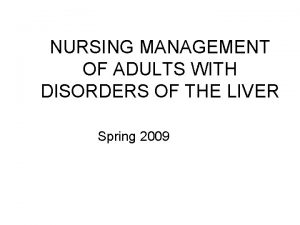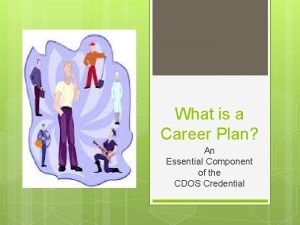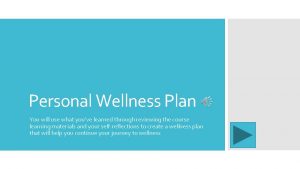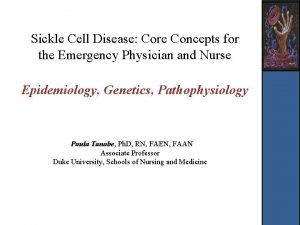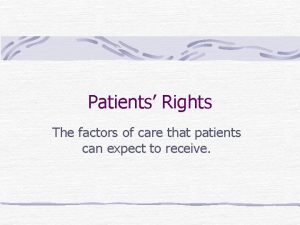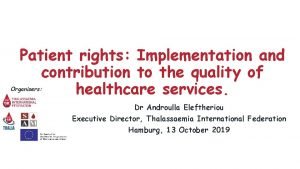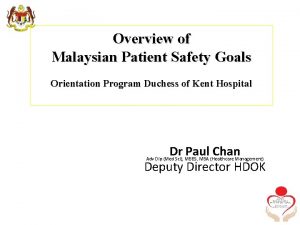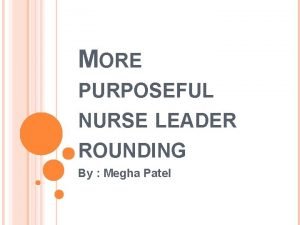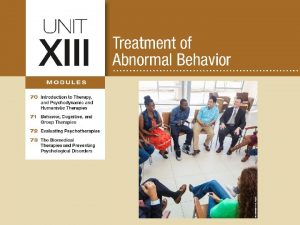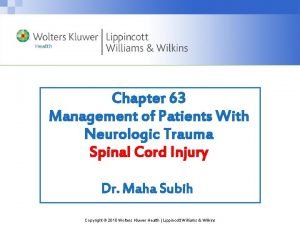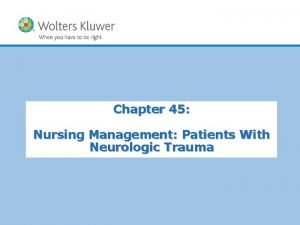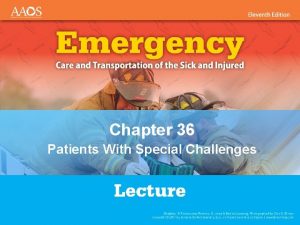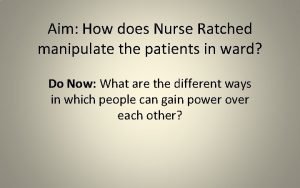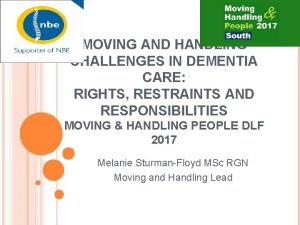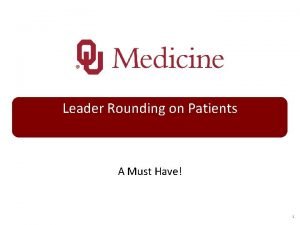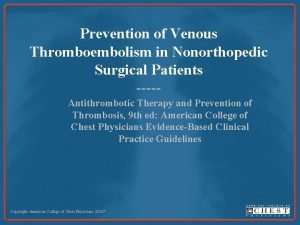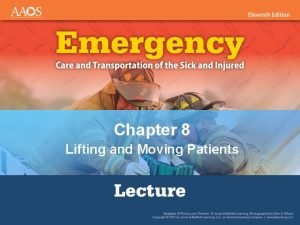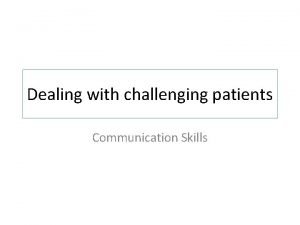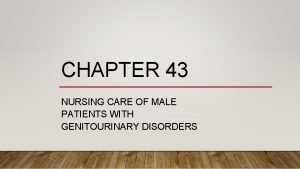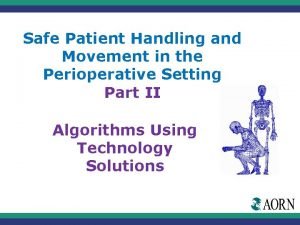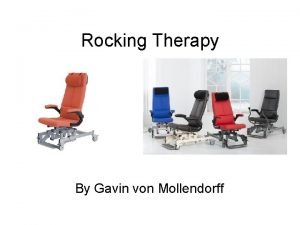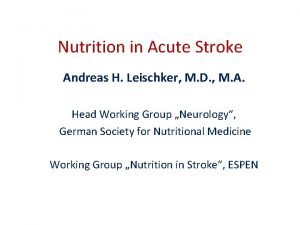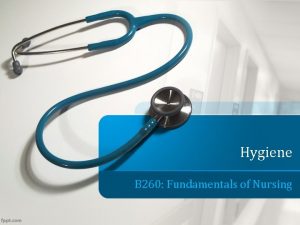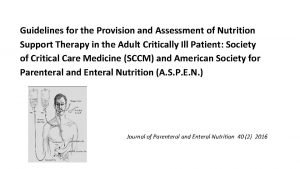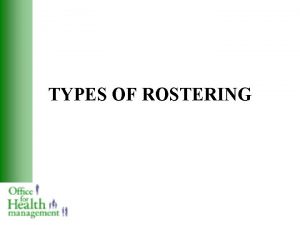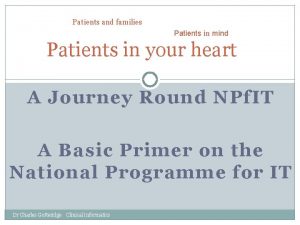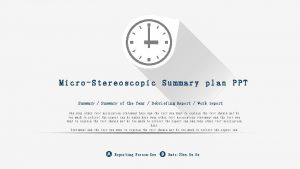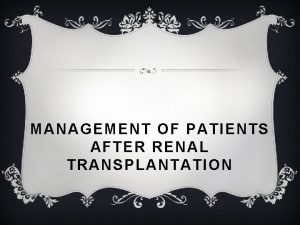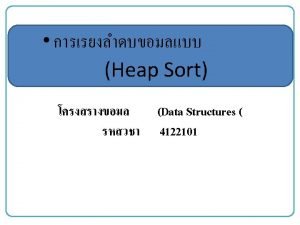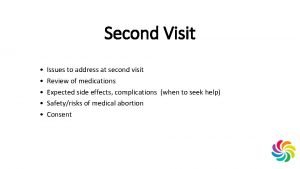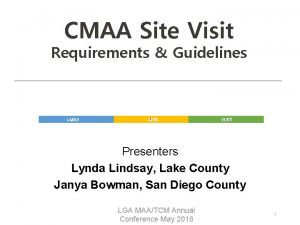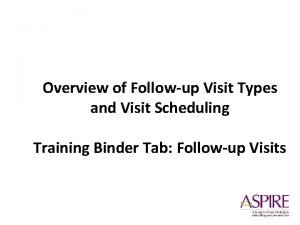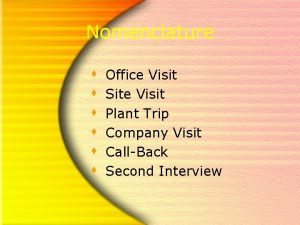The After Visit Summary Developing the Patients Plan






















































- Slides: 54

The After Visit Summary Developing the Patient’s Plan of Care Kimberly Berg, MD Jennifer Frank, MD Theda Care Physicians Neenah, Wisconsin Join the conversation! Our Twitter hashtag is #CPI 2011.

Learning Objectives • Describe elements of a care plan. • Identify common themes that you recommend repeatedly and which can be incorporated into “automatic” plans of care. • Discuss different approaches to creating, distributing, and using an after visit summary.



Where we started from… • Theda. Care Physicians see an average of 1400 patients per day. • Over six weeks, 42% of patients did not have an AVS printed. • A chart review of 286 visits on 2/28/11 found 74% (211) of patients did not receive an AVS or the AVS did not match their plan of care. – 20% of these visits resulted in calls back to clinic. – 14% resulted in telephone messages to providers. – On average, a patient call-back involves multiple staff, takes 20 -30 minutes, and costs about $45

Problem • When patients do not receive a written plan of care (After Visit Summary): – It costs money – It costs time – Patient treatment is delayed – Patients are unhappy

Plan of Care – Why it’s good for business • A printed plan of care clearly reduced number of callbacks related to that office visit • Less callbacks means better utilization of staff • Reduction in volley of phone and other messages • Potential for less errors

Goals/Targets • Goals: The AVS is easy to populate, print and there is standard work that ensures the patient receives it. The AVS is perceived to be of value to providers. The AVS is easy to read-using verbiage that is understandable to our customers. Measure Initial Target Safety/Quality Patients receiving complete accurate AVS with plan reflected in patient instructions Customer Patients receiving AVS Satisfaction 34% 85% 58% 85% People 67% 50% improvement 280 210 (25% reduction) Financial Stewardship Provider engagement with AVS usage (Providers answering usually/always use AVS) Calls back to clinic generated each day (Cost $45 per call or 20+ minutes time for all staff involved)

Balancing two customers • Patient • Clinical staff – Medical assistant – RNs – Front desk staff – Schedulers Image: vichie 81 / Free. Digital. Photos. net

Measurements • Once per month • Manual audit of 4 measures: – Health Maintenance issues addressed – AVS printed – Future labs ordered – Future appointments made

Reflections on What We Learned “We do not learn from experience…we learn from reflecting on experience. ” Donald Schon Our Insights from this Week: (ah-ha) How is the New Process more If we don’t follow rooming standards the Respectful of People? AVS will not be complete. Format is more clear and useful to patients Can’t please everyone-keep focus on patients Will save time for providers and staff in doing re-work How the AVS is used in different offices Challenges to the Change Process: • Engagement of providers and staff • Perception of time commitment Actions Required to Sustain or Build on this Change? • Reinforcement of the purpose of the AVS • Provider to Provider explanation of AVS

Theda. Care AVS Goals • 85% compliance in printed AVS for patients • Endorsed as a 2012 Quality Comp Metric (Part of physician compensation)

What we expect from the After Visit Summary Image: Ambro / Free. Digital. Photos. net

Documentation of the care plan to all members of the team Image: jscreationzs / Free. Digital. Photos. net

What we did today… Image: jscreationzs / Free. Digital. Photos. net

Diagnosis List from Visit Image: jscreationzs / Free. Digital. Photos. net

Updated Medication List Image: Kittikun Atsawintarangkul / Free. Digital. Photos. net

Vital Signs from Visit Image: photostock / Free. Digital. Photos. net

Patient Education Image: jscreationzs / Free. Digital. Photos. net

Losing weight = Change your eating habits + Increase your activity Tips for weight loss: 1) Eat (something) 5 times per day (small meals or large snacks). Incorporate protein into each meal or snack (nuts, eggs, beans/legumes, soy/tofu, lean meat/fish). Emphasize power foods like healthy fats, high protein, and whole grains. 2) Use exercise to promote your overall health. Without reducing your calories, exercise alone may not result in significant weight loss. Get 45 -60 minutes of moderate level physical activity at least 5 days per week. Scheduling time to exercise is challenging for everyone, so make sure you plan this important "appointment" in advance. Being physically fit is healthier than being thin! 3) Don't drink your calories. Avoid diet soda. Choose water or unsweetened iced tea.

Immunizations: The following immunizations are recommended: {IMMUNIZATIONS, ADULT: 17426} Flu shot is recommended annually Cancer Screening: Colorectal cancer screening with colonoscopy is recommended every 10 years starting at age 50 for average risk men Continue to do skin self examinations looking for any moles or skin lesions that are getting bigger, bleeding, changing colors, or are worrying to you Vitamins and Supplements: You should be getting 1000 -1200 mg of calcium each day. One serving of calcium (yogurt, 2 ounces of cheese, glass of milk) has about 250 -300 mg of calcium. I recommend that you get 1000 IU of Vitamin D per day. You should start taking a multivitamin _______ iron. Start taking Fish Oil tablets (1000 mg) 2 -3 times per day to help with your cholesterol. Lifestyle Recommendations: Eat 5 -9 servings of fruits and vegetables each day Add more whole grains (brown bread, brown rice, brown pasta, whole wheat) to your diet Exercise 20 -30 minutes (moderate intensity) most days of the week Wear sunscreen (SPF 15 -30 or greater) on sun exposed areas year-round Get 25 -30 grams of fiber daily Aim for seven to eight hours of sleep nightly Always wear a seatbelt and motorcycle helmet Other recommendations: {NONE/DATE FREE TEXT: 14517}

Recommendations for home care measures Image: Paul / Free. Digital. Photos. net

You have a {URI'S: 25455} -Make sure to get plenty of rest, this will help your body heal. -Be careful to minimize the chance of infecting people you live with, work with, or attend school with by washing hands and covering your mouth when you cough. -Drink plenty of fluids. For cough {COLDREMEDIES: 25456} For sore throat you can use {SORETHROATREMEDIES: 25458} For nasal congestion you can try {COLDREMEDIES: 25456} For chest congestion you can try {COLDREMEDIES: 25456} If you develop fevers, difficulty breathing or if you are not able to keep fluids down, please call the clinic right away. If your symptoms do not improve or resolve within the next 3 -4 days, please call the clinic.

Chronic Disease Report Card

Diabetes Care Progress Report Good diabetes care is more than just checking your blood sugar. Here's how you've been doing: 1. Your blood sugar: The hemoglobin A 1 C measures the average of your blood sugar over the past 3 months. Your goal hemoglobin A 1 C is less than 7%. Your most recent hemoglobin A 1 C was ______ 2. Your blood pressure: Because diabetes affects your blood vessels, it is important to control other things that also affect your blood vessels, like your blood pressure. Your blood pressure goal is less than 130/80. Today your blood pressure was _____ 3. Your cholesterol: _______ 4. Your kidneys: High blood sugar can damage the blood vessels in your kidneys. One of the earliest signs that this is happening is finding protein (called microalbumin) in your urine. Normally, you have no microalbumin in your urine. Your most recent result was {POSITIVE/NEGATIVE: 19873} for early kidney damage. Your plan of care: 1. Medications: There is {INCREASE/DECREASE/NOCHANGE: 24181} in your medication(s). See your medication list which shows all of the medications you should be taking and the correct dosages. 2. Preventive health care: You should have a dilated eye exam every year. You should have regular dental care. A flu vaccine is recommended every year. You should receive a pneumonia vaccine (pneumovax). 3. Lab work: You should have {LABS: 13867} done in {NUMBERS 0 -12: 120000} {WEEKS/MONTHS: 12897}. 4. Your goals: Continue to monitor your blood glucose *** times per {: 20923}. {DIABETES PATIENT INSTRUCTIONS: 20922}.

Incorporating Self-Management

Sample AVS – Acute Care Visit • What are the important elements to include?

Sample AVS – Chronic Care • What are the important elements to include?

Sample AVS – Preventive Health Visit • What are the important elements to include?

Questions for Discussion • Why do patients fail to adhere to treatment plans? • How do treatment plans fail to traverse patient care handoffs? • What are provider barriers to creating and communicating a plan of care? • What are patient barriers to discussing and understanding a plan of care?

What does the evidence say? Image: Keattikorn / Free. Digital. Photos. net

Patient-Centered Labeling Instructions • Standard: – Atenolol 100 mg, once daily • PCL – Atenolol 100 mg, take 1 each morning. • Improved comprehension of medication instructions Wolf et al. Med Care 2011; 49: 96. Image: phanlop 88 / Free. Digital. Photos. net


Using brief counseling and written instructions for colonoscopy prep Rosenfeld et al. Can J Gastroenterol 2010; 24: 543.


Image: photostock / Free. Digital. Photos. net PATIENT VIGNETTE

Hospitalist Communication • Physicians spend more time on written (9. 2 minutes) than verbal (6. 3 minutes) communication • Spend the most time communicating with patients • 30% of the time no verbal communication between nurse and physician Rothberg et al. J Gen Intern Med 2011.

So, do the doctor and nurse agree? Image: photostock / Free. Digital. Photos. net

Agreement between nurse and physician • • • 87% - planned procedures 74% - principal diagnosis 73% - tests ordered 69% - discharge date 59% - medication changes

It’s pretty simple, isn’t it? http: //www. lalamag. ucla. edu/media/images/medical-lrg. jpg

Hospital Discharge Instructions • Standardized electronic discharge instructions • Increased risk of 30 day readmit • No change in ED visits at 30 days Showalter et al. J Gen Intern Med 2011; 26: 718

Do patients understand our instructions? Image: jscreationzs / Free. Digital. Photos. net

ED Discharge Instructions • 78% of patients deficient comprehension with ED plan of care/discharge instructions – Only 20% felt they had difficulty understanding • One-third of those deficient were for post-ED care. (What to do next) Engel et al. Ann Emerg Med 2009; 53: 454.


Post-operative Instructions • Comparison of specific pre-op instructions prior to wrist surgery and written post op instructions (intervention) with: • Standard pre-op instructions and verbal post op instructions (usual care) • Intervention group demonstrated – Decreased VAS scores – Decreased analgesic use – Earlier return to daily activities Makki et al. J Orthop Surg 2011; 19: 85.

• Mailed plan of care reminders to adult patients with h/o childhood cancer regarding recommended screening tests (MMG and echo) • 91% had positive reaction to receiving POC • Increased compliance with screening – 41% MMG – 20% Echo Oeffinger et al. Pediatr Blood Cancer 2011; 56: 818.


Written Action Plans in COPD • Mixed data showing benefit • Increased (appropriate) treatment of acute exacerbations (Wood-Baker 2006) • Adherence with WAP decreased exacerbation recovery time (Bischoff 2011) • Increased knowledge without any other clinically demonstrable benefit (Mc. Geoch 2006)

Pediatric Asthma • No significant outcome difference between WAP users and non-users in inner city pediatric asthma population (Sunshine 2011) • WAP upon ED discharge improved medication adherence, attending recommended f/u, and maintenance medications (Ducharme 2011)


Patient Centered POC • Observed improved A 1 C, LDL, DBP • No difference in SBP, weight • More improvement seen in completely filled out POCs Rocco et al. Qual Manag Health Care 2011; 20: 89.


Small Group Activity • Brainstorm your clinic’s AVS – Paper v electronic – Info to be included • Determine how you will get health care team buy in to devote time and resources • Create clinic flow to incorporate standard use of AVS/POC • Identify how the AVS/POC can be used to improve clinical outcomes

Image: 89 studio / Free. Digital. Photos. net
 After visit summary
After visit summary After me after me after me
After me after me after me If any man desires to come after me
If any man desires to come after me Preoperative nursing care for eye surgery
Preoperative nursing care for eye surgery Sengstaken blakemore tube nursing care
Sengstaken blakemore tube nursing care Rencana aktifitas penjualan
Rencana aktifitas penjualan What is helmholtz watson’s job?
What is helmholtz watson’s job? A visit to grandmother william melvin kelley
A visit to grandmother william melvin kelley Pretest: developing an academic and career plan
Pretest: developing an academic and career plan Sample plan
Sample plan Chapter 35 developing a business plan
Chapter 35 developing a business plan Chapter 35 developing a business plan
Chapter 35 developing a business plan What are the objectives of strategic prospecting?
What are the objectives of strategic prospecting? Developing a personal wellness plan
Developing a personal wellness plan Developing the leader within you summary
Developing the leader within you summary Informal definition in concept paper
Informal definition in concept paper Chapter 2 developing marketing strategies and plans
Chapter 2 developing marketing strategies and plans Romeo and juliet act v study guide
Romeo and juliet act v study guide Life expectancy of sickle cell patients
Life expectancy of sickle cell patients Position of patient in bed
Position of patient in bed Periodontal therapy in female patients
Periodontal therapy in female patients Factors of care a patient can expect
Factors of care a patient can expect Patients rights charter
Patients rights charter Malaysian patient safety goal
Malaysian patient safety goal Nursing interventions for ocd patients
Nursing interventions for ocd patients Studer rounding questions
Studer rounding questions Module 70 introduction to therapy
Module 70 introduction to therapy Extremity lift carry
Extremity lift carry Management of patients with neurologic trauma
Management of patients with neurologic trauma Management of patients with neurologic trauma
Management of patients with neurologic trauma Dope mnemonic emt
Dope mnemonic emt How does nurse ratched manipulate the patients
How does nurse ratched manipulate the patients What is patient admission
What is patient admission Non-infective
Non-infective Moving and handling dementia patients
Moving and handling dementia patients Leader rounding on patients
Leader rounding on patients Ethical issues in treating lgbt patients
Ethical issues in treating lgbt patients Diagnosis and treatment planning in complete denture pdf
Diagnosis and treatment planning in complete denture pdf Prevention of vte in nonorthopedic surgical patients
Prevention of vte in nonorthopedic surgical patients Rapid extrication technique
Rapid extrication technique Dealing with challenging patients
Dealing with challenging patients High fowlers position
High fowlers position Nursing diagnosis for undescended testis
Nursing diagnosis for undescended testis Pico examples
Pico examples Safe patient handling algorithms
Safe patient handling algorithms Rocking chair therapy for dementia patients
Rocking chair therapy for dementia patients Broadmoor hospital inmates
Broadmoor hospital inmates 12 patient rights
12 patient rights Guideline clinical nutrition in patients with stroke
Guideline clinical nutrition in patients with stroke Correction factor insulin
Correction factor insulin Define inadequate
Define inadequate Hygiene fundamentals of nursing
Hygiene fundamentals of nursing Diet chart for icu patients
Diet chart for icu patients Some patients shout in pain while ______ an injection.
Some patients shout in pain while ______ an injection. Self rostering system
Self rostering system




